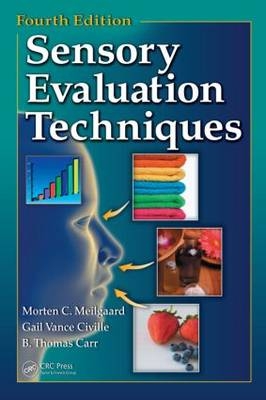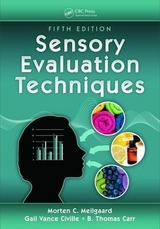
Sensory Evaluation Techniques, Fourth Edition
Crc Press Inc (Verlag)
978-0-8493-3839-7 (ISBN)
- Titel erscheint in neuer Auflage
- Artikel merken
From listing the steps involved in a sensory evaluation project to presenting advanced statistical methods, Sensory Evaluation Techniques, Fourth Edition covers all phases of sensory evaluation. Like its bestselling predecessors, this edition continues to detail all sensory tests currently in use, to promote the effective employment of these tests, and to describe major sensory evaluation practices.
The expert authors have updated and added many areas in this informative guide. New to this edition are expanded chapters on qualitative and quantitative consumer research and the Spectrum™ method of descriptive sensory analysis that now contains full descriptive lexicons for numerous products, such as cheese, mayonnaise, spaghetti sauce, white bread, cookies, and toothpaste. Also new in this chapter is a set of revised flavor intensity scales for crispness, juiciness, and some common aromatics. The book now includes an overview of Thurstonian scaling that examines the decision processes employed by assessors during their evaluations of products. Another addition is a detailed discussion of data-relationship techniques, which link data from diverse sources that are collected on the same set of examples.
With numerous examples and sample tests, Sensory Evaluation Techniques, Fourth Edition remains an essential resource that illustrates the development of sensory perception testing.
Preface
INTRODUCTION TO SENSORY TECHNIQUES
Introduction
Development of Sensory Testing
Human Subjects as Instruments
Conducting a Sensory Study
SENSORY ATTRIBUTES AND THE WAY WE PERCEIVE THEM
Introduction
Sensory Attributes
The Human Senses
Perception at Threshold and Above
CONTROLS FOR TEST ROOM
Introduction
Environmental Controls
Product Controls
Panelist Controls
FACTORS INFLUENCING SENSORY VERDICTS
Introduction
Physiological Factors
Psychological Factors
Poor Physical Condition
MEASURING RESPONSES
Introduction
Psychophysical Theory
Classification
Grading
Ranking
Scaling
OVERALL DIFFERENCE TESTS: DOES A SENSORY DIFFERENCE EXIST BETWEEN SAMPLES?
Introduction
The Unified Approach to Difference and Similarity Testing
Triangle Test
Duo-Trio Test
Two-Out-of-Five Test
Same/Different Test (or Simple Difference Test)
"A" - "Not A" Test
Difference-from-Control Test
Sequential Tests
ATTRIBUTE DIFFERENCE TESTS: HOW DOES ATTRIBUTE X DIFFER BETWEEN SAMPLES?
Introduction: Paired Comparison Designs
Directional Difference Test: Comparing Two Samples
Pairwise Ranking Test: Friedman Analysis-Comparing Several Samples in All Possible Pairs
Introduction: Multisample Difference Tests-Block Designs
Simple Ranking Test: Friedman Analysis-Randomized (Complete) Block Design
Multisample Difference Test: Rating Approach-Evaluation by Analysis of Variance (ANOVA)
Multisample Difference Test: BIB Ranking Test (Balanced Incomplete
Block Design)-Friedman Analysis
Multisample Difference Test: BIB Rating Test (Balanced Incomplete
Block Design)-Evaluation by Analysis of Variance
DETERMINING THRESHOLD
Introduction
Definitions
Applications of Threshold Determinations
SELECTION AND TRAINING OF PANEL MEMBERS
Introduction
Panel Development
Selection and Training for Difference Tests
Selection and Training of Panelists for Descriptive Testing
Panel Performance and Motivation
Appendix 1: Prescreening Questionnaires
Appendix 2: Panel Leadership Advice
DESCRIPTIVE ANALYSIS TECHNIQUES
Definition
Field of Application
Components of Descriptive Analysis
Commonly Used Descriptive Test Methods
Application of Descriptive Analysis Panel Data
THE SPECTRUM™ DESCRIPTIVE ANALYSIS METHOD
Designing a Descriptive Procedure
Myths about the Spectrum Descriptive Analysis Method
Terminology
Intensity
Other Options
Modified Short-Version Spectrum Descriptive Procedures for Quality Assurance, Shelf-Life Studies, etc.
Appendix 1: Spectrum Terminology for Descriptive Analysis
Appendix 2: Spectrum Intensity Scales for Descriptive Analysis
Appendix 3: A Streamlined Approach to Spectrum References
Appendix 4: Spectrum Descriptive Analysis Product Lexicons
Appendix 5: Spectrum Descriptive Analysis Examples of Full Product Descriptions
Appendix 6: Spectrum Descriptive Analysis Training Exercises
AFFECTIVE TESTS: CONSUMER TESTS AND IN-HOUSE PANEL ACCEPTANCE TESTS
Purpose and Applications
The Subjects/Consumers in Affective Tests
Choice of Test Location
Affective Test Methods-Fuzzy Front End
Affective Methods: Qualitative
Affective Methods: Quantitative
Internet Research
Using Other Sensory Methods to Uncover Insights
Appendix 1: Screeners for Consumer Studies-Focus Group, CLT, and HUT
Appendix 2: Discussion Guide-Group or One-on-One Interviews
Appendix 3: Questionnaires for Consumer Studies
Appendix 4: Protocol Design for Consumer Studies
Appendix 5: Additional Fuzzy Front End References
BASIC STATISTICAL METHODS
Introduction
Summarizing Sensory Data
Statistical Hypothesis Testing
Thurstonian Scaling
The Statistical Design of Sensory Panel Studies
Appendix on Probability
ADVANCED STATISTICAL METHODS
Introduction
Data Relationships
Preference Mapping
The Treatment Structure of an Experimental Design
GUIDELINES FOR CHOICE OF TECHNIQUE
Introduction
GUIDELINES FOR REPORTING RESULTS
Introduction
Summary
Objective
Experimental
Results and Discussion
STATISTICAL TABLES
Index
References appear at the end of each chapter.
| Erscheint lt. Verlag | 13.12.2006 |
|---|---|
| Zusatzinfo | 1 Halftones, black and white; 102 Tables, black and white; 116 Illustrations, black and white |
| Verlagsort | Bosa Roca |
| Sprache | englisch |
| Maße | 178 x 254 mm |
| Gewicht | 1043 g |
| Themenwelt | Technik ► Lebensmitteltechnologie |
| ISBN-10 | 0-8493-3839-5 / 0849338395 |
| ISBN-13 | 978-0-8493-3839-7 / 9780849338397 |
| Zustand | Neuware |
| Haben Sie eine Frage zum Produkt? |
aus dem Bereich



